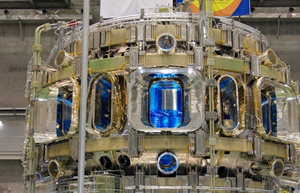Cryostat of Korean fusion experiment KSTAR installed
On 11 January 2007, the cryostat cylinder of the KSTAR tokamak — constructed by the Korean National Fusion Research Center (NFRC) — was installed, signifying that more than 95% of the tokamak assembly is now completed. The closure ceremony was attended by Mr. Kim Woo Sik, Vice Prime-Minister of the Korean Ministry of Science and Technology. The KSTAR project was launched in 1995. Its mission is to develop a fully superconducting medium-size tokamak similar in size to ASDEX-Upgrade in Germany and DIII-D in the United States.
The goal of the Korean fusion programme is to contribute to the development of fusion energy by providing useful technical information, via KSTAR, to the ITER programme and to join in the future foreseen development path for future fusion power plants.
NFRC expects that due to its long-pulse D-shaped plasma characteristics and modest operation cost, KSTAR can serve as a useful pilot experimental device prior to ITER operation. Its expected 4 to 5 years of high power long-pulse operation before ITER comes online can provide useful technical knowledge and data for ITER operation.
The South Korean government plans to produce a long-term plan this year focused on nuclear fusion energy. More information can be found on the KSTAR website.


